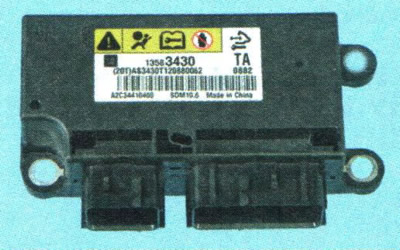
WARNINGS: Airbags do not replace seat belts. Moreover, when the car is moving, the driver and front passenger must be sure to wear their seat belts, since in the event of a traffic accident, a deployed airbag itself can cause serious injury to a person who is not wearing a seat belt. In addition, passengers in the back seat must be fastened with seat belts. In the event of an accident, an unbelted passenger in the rear seat can cause injury and serious injury to all passengers in the vehicle.
The SRS system includes the following elements:

- a driver airbag module located in the steering wheel hub and consisting of a folded airbag shell and an inflator;

- the front passenger airbag module, located in the instrument panel on the passenger side and consisting of a folded airbag shell and an inflator;
- driver and front passenger side airbag modules (installed depending on the vehicle), located in the outer side parts of the front seat backs and consisting of a folded cushion shell and a gas generator;
- driver and front passenger air curtain modules (installed depending on the vehicle), located under the facings of the front and rear pillars of the body and consisting of a folded cushion shell and a gas generator;

- an electronic control unit installed under the lining of the floor tunnel and controlling the system;

- front and side impact sensors that transmit acceleration information to the system control unit;

- seat belts.
The strength and direction of impact in a traffic accident is determined by the electronic control unit (ECU) passive safety system using shock sensors. Based on the signals from the sensors, the control unit activates the airbags.
Upon impact of a certain force, the ECU, having received signals from the impact sensors, before activating the airbags, increases the tension of the belts, issuing a command to the pyrotechnic elements of the pretensioners. The latter provide a timely response to an emergency deceleration of the car, pulling the driver and passenger to the seat backs, and exclude their further movement by inertia forward or sideways and getting injured from a deployed airbag.
NOTE: The seat belt pretensioner mechanism always deploys before the airbag.
Additional elements of the passive safety system also include head restraints mounted on the backs of the driver's, front passenger's and rear seats. The head restraints prevent damage to the cervical vertebrae of occupants in the event of a severe rear impact or airbag deployment.
